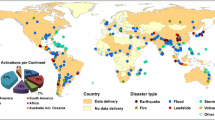Abstract
The paper substantiates and briefly describes an innovative project aimed at creating and using in practice effective space-, aviation, and ground-based early warning and monitoring technologies for precursors to large-scale earthquakes in order to increase the accuracy and reliability in the short-term forecasting of times and places of disasters. The innovative scheme, which envisages the use of paired satellite equipment with controlled distance and information exchange between them, will make it possible to obtain data on the spatial structure and dynamic characteristics of studied phenomena, substantially increasing the reliability in detecting earthquake-related signals from a set of other natural phenomena. A distinctive feature of the project is a three-tiered system and multiparameter analysis of a wide set of precursor signals simultaneously revealed by different methods in different media, which significantly increases the accuracy and reliability in short-term earthquake forecasts. We present a stage-by-stage practical implementation scheme and a business model that will guarantee a swift return on investments and the economic viability of the project as a whole.


Similar content being viewed by others
REFERENCES
Chmyrev, V.M., Isaev, N.V., Serebryakova, O.N., Sorokin, V.M., and Sobolev, Ya.P., Small-scale plasma inhomogeneities and correlated ELF emissions in the ionosphere over an earthquake region, J. Atmos. Sol.-Terr. Phys., 1997, vol. 59, pp. 967–973.
Chmyrev, V., Smith, A., Kataria, D., Nesterov, B., Owen, C., Sammonds, P., Sorokin, V., and Vallianatos, F., Detection and monitoring of earthquake precursors: TwinSat, a Russia–UK Satellite Project, Adv. Space Res., 2013, vol. 52, pp. 1135–1145.
Rogozhin, E.A., Ioganson, L.I., Zav’yalov, A.D., Zakharov, V.S., Lutikov, A.I., Slavina, L.B., Reisner, G.I., Ovsyuchenko, A.N., Yunga, S.L., and Novikov, S.S., Potentsial’nye seismicheskie ochagi i seismologicheskie predvestniki zemletryasenii – osnova real’nogo seismicheskogo prognoza (Potential Seismic Sources and Seismological Precursors of Earthquakes as the Basis of Real Seismic Forecast), Moscow: Svetoch-Plyus, 2011.
Rogozhin, E.A., Lutikov, A.I., Sobisevich, L.E., To Shen, and Kanonidi, K.Kh., The Gorkha earthquake of April 25, 2015 in Nepal: Tectonic position, aftershock process, and possibilities of forecasting the evolution of seismic situation, Izv., Phys. Solid Earth, 2016, vol. 52, no. 4, pp. 534–549. doi 10.1134/S1069351316040078
Sorokin, V.M. and Chmyrev, V.M., Atmosphere–ionosphere electrodynamic coupling, in The Atmosphere and Ionosphere: Dynamics, Processes and Monitoring, Bychkov, V.L., Golubkov, G.V., and Nikitin, A.I., eds., Dordrecht: Springer, 2010, pp. 97–146.
Sorokin, V.M. and Pokhotelov, O.A., Generation of ULF geomagnetic pulsations during early stage of earthquake preparation, J. Atmos. Sol.-Terr. Phys., 2010, vol. 72, pp. 763–766.
Sorokin, V.M., Chmyrev, V.M., and Yaschenko, A.K., Electrodynamic model of the lower atmosphere and the ionosphere coupling, J. Atmos. Sol.-Terr. Phys., 2001, vol. 63, pp. 1681–1691.
Sorokin, V.M., Ruzhin, Yu.Ya., Yaschenko, A.K., and Hayakawa, M., Generation of VHF radio emissions by electric discharges in the lower atmosphere over a seismic region, J. Atmos. Sol.-Terr. Phys., 2011, vol. 73, pp. 664–670. doi 10.1016/j.jastp.2011.01.016
Sorokin, V., Chmyrev, V., and Tronin, A., Osnovy aerokosmicheskikh metodov monitoringa zemletryasenii (Fundamentals of Aerospace Methods of Earthquake Monitoring), Saarbrucken: Palmarium Academic Publishing, 2014.
Sorokin, V., Chmyrev, V., and Hayakawa, M., Electrodynamic Coupling of Lithosphere-Atmosphere-Ionosphere of the Earth, New York: Nova Science Publishers, Inc., 2015.
Tronin, A., Satellite remote sensing in seismology. A review, Remote Sens., 2010, vol. 2, pp. 124–150. doi https://doi.org/10.3390/rs2010124
Wang Lanwei, Shen Xuhui, Yuan Shigeng, Zhang Yu, and Yan Rui, Introduction of the first China seismo-electromagnetic satellite project, 2nd International DEMETER Workshop, Paris, France, 2011.
Author information
Authors and Affiliations
Corresponding authors
Additional information
Translated by A. Carpenter
About this article
Cite this article
Rogozhin, E.A., Chmyrev, V.M., Pokhotelov, O.A. et al. Project TWINSAT: Development of Integrated Aerospace and Ground-Based Early Warning and Monitoring Technologies for Precursors to Large-Scale Natural Disasters. Seism. Instr. 54, 521–530 (2018). https://doi.org/10.3103/S0747923918050122
Published:
Issue Date:
DOI: https://doi.org/10.3103/S0747923918050122




